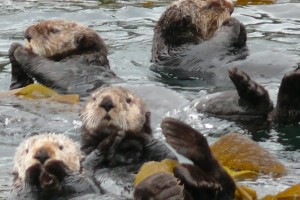Several Alaska Native organizations oppose a legislative effort to increase sea otter harvests. But they support efforts to get Alaskans more involved in federal management of the once-rare marine mammals.
The voracious marine mammals are expanding in number and range in Southeast and some other coastal areas. Crabbers and divers say otters are decimating populations of crab and other shellfish they gather for commercial or subsistence use.

Alaska Natives are allowed to hunt otters, but face strict federal limits on how they are used. Full pelts can be sold to other Natives. Traditional products, such as clothing or regalia, can be sold to anyone.
Representative Peggy Wilson, a Wrangell Republican, authored the legislative resolution asking federal authorities to work with state and Native leaders to allow more hunts.
“We’re hoping that the Natives can do what they traditionally have done for years. And they can be able to harvest (otters), use their skins to make other things so that they can make money. If we just keep it to them, we’re not going to overharvest by any means of the imagination,” Wilson says.
Wilson’s resolution would allow whole pelts to be sold to non-Natives, which is now illegal. She recently told the House Resources Committee that would boost harvests and lessen impacts on fisheries.
Tlingit-Haida Central Council President Ed Thomas says that could create problems.
“The biggest threat is that if we were allowed to sell those pelts unaltered, you could pretty much guess, if you look down here on South Franklin (Juneau’s tourist district), that they would come back as ‘authentic’ Native crafts made in Taiwan,” Thomas says.
Thomas supports other parts of the resolution calling for a new federal management plan that increases otter harvests.
So does Rosita Worl, who spoke on behalf of the Alaska Federation of Natives, Sealaska Corporation and the Sealaska Heritage Institute.
Sealaska and tribal governments in Sitka and Petersburg are among those trying to expand pelt processing. Worl says they’re providing training and equipment needed to support a growing cottage industry.
“We see sea otters as just one answer to trying to promote sustainable economies in our communities,” Worl says.
She says the current law is interpreted too narrowly. She wants Native craftspeople to be able to make and sell a wider variety of otter products, such as teddy bears.
“We’ve had a number of our people that have been cited. We’ve complained vigorously about the enforcement practices. We’ve advanced the ideas of co-management. But our idea was to really change the marine mammal law that would allow for the sale of contemporary items,” she says.
House Joint Resolution 26, Wilson’s measure, was introduced last year. Its first hearing was February 3rd in the House Resources Committee. It remains before that panel.
If passed, it will be sent to Alaska’s Congressional delegation and the Secretary of the federal Department of the Interior.
Ed Schoenfeld is Regional News Director for CoastAlaska, a consortium of public radio stations in Ketchikan, Juneau, Sitka, Petersburg and Wrangell.
He primarily covers Southeast Alaska regional topics, including the state ferry system, transboundary mining, the Tongass National Forest and Native corporations and issues.
He has also worked as a manager, editor and reporter for the Juneau Empire newspaper and Juneau public radio station KTOO. He’s also reported for commercial station KINY in Juneau and public stations KPFA in Berkley, WYSO in Yellow Springs, Ohio, and WUHY in Philadelphia. He’s lived in Alaska since 1979 and is a contributor to Alaska Public Radio Network newscasts, the Northwest (Public Radio) News Network and National Native News. He is a board member of the Alaska Press Club. Originally from Cleveland, Ohio, he lives in Douglas.




